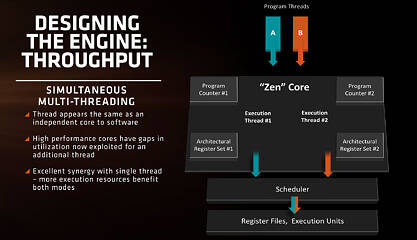 99
99
AMD Ryzen 9 3900X, SMT on vs SMT off, vs Intel 9900K
Test Setup »Introduction

The AMD Ryzen 9 3900X is the most powerful mainstream-desktop processor you can buy right now, and our comprehensive review of the chip shows it blow the competition to smithereens when it comes to multi-threaded tasks that can scale across multiple cores. It also performs very close to Intel's offerings at gaming.
Although over the past decade games have grown to leverage multi-core processors better, they still don't need HEDT-like core counts. "Battlefield V," for instance, was coded to leverage up to 12 logical processors. "Metro Exodus" and "Assassin's Creed Odyssey" can scale across a few more cores. There still remain games that don't need too many cores and benefit simply from high CPU clock speeds or IPC. This is probably why Intel didn't bother giving most of its desktop processors HyperThreading. The 6-core/6-thread Core i5-9600K is still being marketed as a gamer's CPU.

The Ryzen 9 3900X, thanks to SMT, or simultaneous multi-threading, can give your machine 24 logical processors, or threads. Identical in concept to Intel's HyperThreading, SMT treats each physical CPU core as two logical processors, so its machinery can be more optimally utilized. In theory, though SMT or HTT adds to the processor's power draw, latencies can pose compatibility issues with certain older software, or software that isn't coded too well to use it.
Nearly all PC platforms designed for multi-core processors offer two important settings in their BIOS setup programs: the ability to disable SMT or HTT and the ability to disable cores within a multi-core processor. These two settings come in handy for compatibility or troubleshooting, especially if you're a software developer trying to optimize or test your code. For most people, the settings don't make much sense, and so motherboards by default enable SMT/HTT on processors that feature it.
With a physical CPU core count as high as 12, we wondered how disabling SMT impacts the performance of a Ryzen 9 3900X and whether the processor in any way benefits from its disabling for certain kinds of applications or games. When you disable SMT, you shave off half the number of logical processors your operating system's scheduler has to address. Every processor it dispatches work to is guaranteed to be a full physical core with its L1/L2 caches, and integer and FPU pipes are fully dedicated to that workload. In theory, this should benefit software that don't scale across too many logical processors. Each core's scheduler isn't juggling resources between two threads, and so latencies should also be down.
In this review, we test a Ryzen 9 3900X with SMT disabled, making it a 12-core/12-thread processor. The processor is put through our entire CPU test bench and a number of games. We explore whether the 3900X with SMT disabled can be a viable daily-use solution for high-end gaming PC builds in which the user is more focused on gaming and light productivity. We are testing two theories: the extent of performance loss in multi-threaded tests and performance gain (if any) in tests that aren't too parallelized.
Apr 26th, 2024 07:29 EDT
change timezone
Latest GPU Drivers
New Forum Posts
- Best SSD for system drive (85)
- The Official Linux/Unix Desktop Screenshots Megathread (695)
- Horizontal black lines popping up on my screen? (9)
- What's your latest tech purchase? (20347)
- Share your AIDA 64 cache and memory benchmark here (2918)
- Secure boot already open help (1)
- What are you playing? (20535)
- TPU's Nostalgic Hardware Club (18472)
- Last game you purchased? (258)
- Alphacool CORE 1 CPU block - bulging with danger of splitting? (22)
Popular Reviews
- HYTE THICC Q60 240 mm AIO Review
- MOONDROP x Crinacle DUSK In-Ear Monitors Review - The Last 5%
- Alienware Pro Wireless Gaming Keyboard Review
- Upcoming Hardware Launches 2023 (Updated Feb 2024)
- Thermalright Phantom Spirit 120 EVO Review
- ASUS Radeon RX 7900 GRE TUF OC Review
- RTX 4090 & 53 Games: Ryzen 7 5800X vs Ryzen 7 5800X3D Review
- FiiO K19 Desktop DAC/Headphone Amplifier Review
- NVIDIA RTX 4090: 450 W vs 600 W 12VHPWR - Is there any notable performance difference?
- RTX 4090 & 53 Games: Core i9-13900K vs Ryzen 7 5800X3D Review
Controversial News Posts
- Windows 11 Now Officially Adware as Microsoft Embeds Ads in the Start Menu (123)
- Sony PlayStation 5 Pro Specifications Confirmed, Console Arrives Before Holidays (117)
- NVIDIA Points Intel Raptor Lake CPU Users to Get Help from Intel Amid System Instability Issues (106)
- AMD "Strix Halo" Zen 5 Mobile Processor Pictured: Chiplet-based, Uses 256-bit LPDDR5X (101)
- US Government Wants Nuclear Plants to Offload AI Data Center Expansion (98)
- AMD's RDNA 4 GPUs Could Stick with 18 Gbps GDDR6 Memory (89)
- Developers of Outpost Infinity Siege Recommend Underclocking i9-13900K and i9-14900K for Stability on Machines with RTX 4090 (85)
- Windows 10 Security Updates to Cost $61 After 2025, $427 by 2028 (84)

